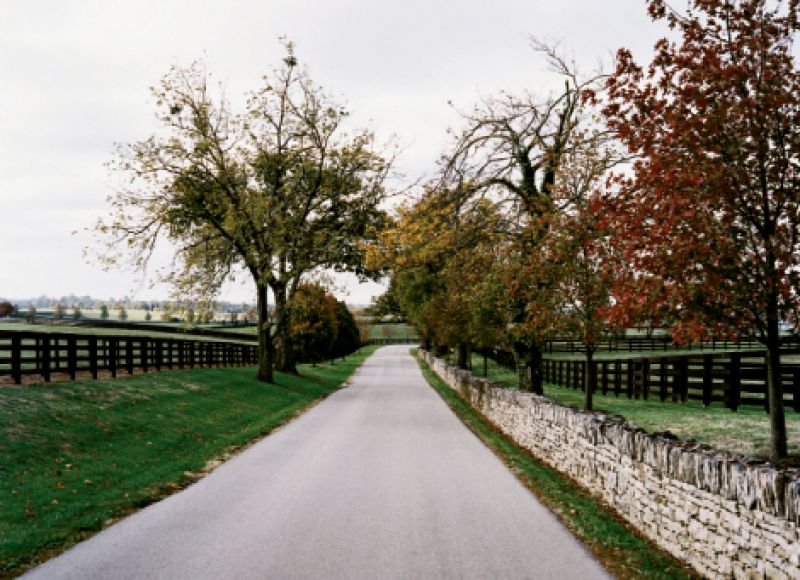
While perusing the dinner menu at Jonathan’s at Gratz Park Inn, one of Lexington, Kentucky’s finer establishments, my eyes fell on the filet wrapped with Maker’s Mark barrel-smoked bacon—sinful, without a doubt. But the butterscotch crème brûlée torched with a splash of Booker’s bourbon looked downright hedonistic. Seeing as how my traveling partner and I were already planning on indulgence, it seemed apropos to enjoy the decadent meal with Kentucky’s signature libation: bourbon. At the server’s recommendation, I was presented the 1792 Ridgemont Reserve, which is not, as you may think, a spirit from the Whiskey Rebellion era; rather, its date signifies when Kentucky became a commonwealth (the liquor is actually aged eight years). I inhaled the aroma—slightly fruity and sweet, with vanilla undertones. And the taste offered a smooth tinge of spice. With that first sip, I couldn’t wait to begin our “spirited” quest—a tour of eight distilleries along the Kentucky Bourbon Trail. Like California wine country is to oenophiles, Central Kentucky is a mecca for bourbon aficionados. A mild climate coupled with access to ample amounts of corn and limestone water render it an ideal place for producing the libation. As the liquor originated here, it’s no surprise that this is the epicenter of the world’s production (95 percent according to the Kentucky Distillers’ Association) and the place for all things bourbon. So rather than trek to Mondavi, I had come to visit Jim, Mark, Woodford, and others to learn how it’s done.
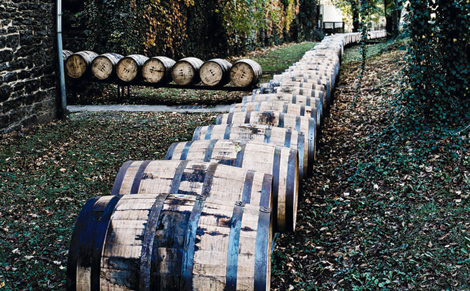
With plans to watch an afternoon race at Lexington’s legendary Keene-land track, we set out early in the crisp autumn air to take in our first distillery. The 30-minute drive into the countryside took us past sweeping hills and pastures ablaze with deep red, ochre, and orange. Picturesque horse farms preceded the bend in the road that led us to Woodford Reserve Distillery in Versailles. Amid various buildings, three limestone warehouses dating to the 1830s house stills and storage space for 10,000 barrels of bourbon, which is slowly acquiring its color, flavor, and strength in terms of proof.
Our guided tour began in the still house, where a strong, yeasty aroma reminiscent of rising bread hung in the air. Four cypress fermenting tanks fill the room, each holding 7,500 gallons of mash, the bubbling concoction of cooked grains, water, and yeast. “To be called bourbon,” our guide, Steve Binegar, explained, “it must contain at least 51 percent corn and can only be distilled up to 160 proof. It must be aged in the U.S. for at least two years in new, charred, white oak barrels, and water is the only thing that can be added to enhance the flavor or color.”
The adjacent room revealed three bulbous copper pot stills. Woodford distills its bourbon three times (rather than the standard two) in these custom apparatuses. Essentially, this is where the alcohol is separated from the mash and the proof increases. Binegar ushered us past an attractive cooperage display explaining how the barrels are made and where they are filled, corked, and sent down the barrel run to the warehouses for storage.
The tour concluded at the visitor’s center, where just a sip of the namesake bourbon, which tastes of buttery caramel and spice, was enough to prompt a big buy.
Getting There
Woodford Reserve Distillery, 7855 McCracken Pike, Versailles, KY, (859) 879-1812, www.woodfordreserve.com. General tours, $5 (free for those under 18), Tuesday-Saturday, 9 a.m-5 p.m., year-round; Sunday 12:30-4 p.m., April-October. Tours start on the hour, last one at 3 p.m. Specialized tours are $10 and require advance reservations.

Bidding farewell to Lexington the next morning, we headed toward Frankfort. There, on the banks of the Kentucky River, a 170-foot water tower bearing the Buffalo Trace Distillery trademark rises above an industrial landscape of nearly 100 buildings that represent three centuries of architecture. Most notable are the handful of brick rickhouses (or barrel warehouses) reflecting the industry’s distinctive construction style of the late-1800s. Our guide, Don Flinn, relayed the land’s history: It was once a migratory route, or trace, carved by buffalo and later followed by westward explorers.
Though the working parts of the still are not open to the public, behind-the-scenes tours can be arranged. All the distilleries cover similar bases, but each offers a truly unique experience. In this case: a glimpse inside Blanton’s Bottling Hall, where Buffalo Trace readies its finest bourbons for shipment.
“In comparison to a single-barrel bourbon,” Flinn said, “‘small batch’ means that the contents of multiple barrels—sometimes as few as 15 or as many as 100—are mixed and bottled.” It’s a task left in the trusted hands of about 20 employees who fill, cap, label, and package its premium bourbons. Though the distillery makes more than a dozen specialty labels, on this day, the staff was bottling a batch of Blanton’s, a single-barrel bourbon that retails for about $50.
Walking down the aisles, I was able to ask questions, and if there had been an extra seat, I doubt anyone would’ve cared if I’d sat down and shadowed. After witnessing the care given to each bottle, which is capped with a tiny statue of a horse and jockey, I couldn’t wait for a taste. Vanilla and caramel flavors, as well as hints of honey and pepper happily surprised me.
Getting There
Buffalo Trace Distillery, 113 Great Buffalo Trace, Frankfort, KY, (800) 654-8471, www.buffalotrace.com. Free one-hour tours on the hour Monday-Friday, 9 a.m.-3 p.m.; Saturday, 10 a.m.-2 p.m. The free “Hard Hat Tour” (behind-the-scenes of the bourbon-making process) and “Post Prohibition Tour” (a look into the history of the buildings) are by appointment only.
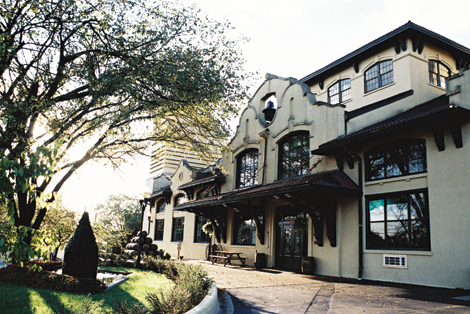
The 20-minute drive south to Four Roses was no problem, as Kentucky state law prohibits tasting any more than the equivalent of about half a shot on the tours. Prior to this trip, I had never tried this label, but it came highly recommended from a bourbon-loving friend. Adding to the intrigue, the graceful 1910 distillery boasts Spanish Mission architecture—certainly a novelty in rural Lawrenceburg.
Like most of the state’s distilleries, Four Roses is an old brand, dating to the 1860s, and has changed hands many times. When Seagram took ownership in the mid-1900s, the sale of Four Roses bourbon ceased in the U.S. and was shifted to Europe and Japan, where it remains hugely popular. Though production never left Kentucky, it wasn’t until after the Japanese corporation Kirin bought the label in 2002 that it again became available in the States.
Listening intently as our guide gave her introduction, we learned the tour would be cut short due to drought. “Four Roses uses about 700,000 gallons of water per day,” she explained. Iron-free, calcium-rich limestone water regulates the proof and is used in various stages of the process. And since Four Roses’ water source, the Salt River, was running low, production was at a standstill.
We missed seeing the hammer mill and fermenters, but we did visit the grain lab—where corn, rye, and barley are evaluated—and the still. In the tasting room, I savored the delicate Four Roses Single Barrel and considered the importance of water, how you need a lot of it for making bourbon—and even more if you imbibe on the heavy side.
Getting There
Four Roses, 1224 Bonds Mill Rd.,
Lawrenceburg, KY, (502) 839-3436,
www.fourroses.us. Free tours on the hour Monday-Saturday, 9 a.m.-3 p.m., mid-September through June.

Nearby, another distillery was up and running. Situated on a limestone bluff high above the Kentucky River in Bardstown, Wild
Turkey, Rare Breed Distilling Company is not the polished showpiece of its counterparts. You won’t find sleek displays, striking architecture, or a fancy tasting room here. But you will see the working parts of a still, and you’d be just as likely to cross paths with veteran master distiller Jimmy Russell as you would Olivia Ripy, whose ancestors built the distillery in 1869.
My friend and I arrived at the visitor’s center just after 2:30 p.m. when the last tour departed, but lucky for us, Jimmy’s son, associate distiller Eddie, obliged to show us around. “My father likes to tell everybody that I’m the newcomer in the business. I’ve only got 29 years of experience,” he said with a grin as we followed the painted turkey tracks up the hill to the distillery. “But he’s been here for 54 years, so I figure it’s okay for him to say that.”
In fact, Jimmy is the longest-running master bourbon distiller. While father and son assume different duties—Jimmy orders the grains and dictates the recipes and proofs; Eddie oversees the day-to-day operations of cooking the mash and filling the barrels—both sample the product daily, tasting from as many as 30 barrels, but more often around eight to 10.
As I dreamed about a new career in quality control, Eddie took us around the facility, telling us about their $50-million expansion and conversion from coal to wood. And while this is the only distillery tour that doesn’t offer a tasting, I happily purchased a bottle of Russells’ Reserve—a 10-year-old, 90-proof bourbon with a short, smooth finish.
Polishing off the day in Bardstown, we spent the night in the reportedly haunted old Nelson County jail, aka the Jailer’s Inn B&B, and even slept in one of the cells.
Getting There
Wild Turkey, 1525 Tyrone Rd. (U.S. Hwy. 62 E.), Lawrenceburg, KY, (502) 839-2182, www.wildturkeybourbon.com. Free tours Monday-Saturday, 9 a.m., 10:30 a.m., 12:30 p.m., 2:30 p.m.
No tastings.
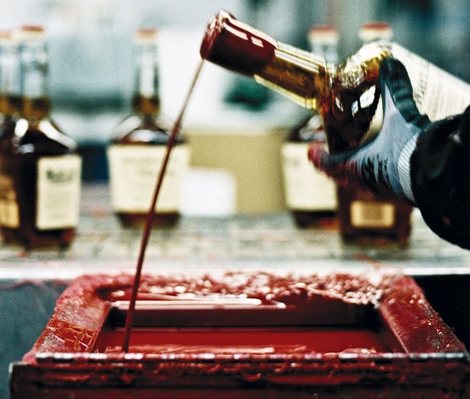
Driving down State Highway 49 toward Loretto, signs bearing the iconic Maker’s Mark name lead deep into the countryside. A refurbished late-1800s tollgate—now a café that serves bourbon-inspired bites—welcomes you to a collection of black, burgundy, and cream-clad structures dotting the property. We first visited the Distiller’s House, the original 1950s home of Bill Samuels Sr., who, after burning his ancestor’s 170-year-old recipe, created the company’s unique wheat bourbon. (Wheat replaced rye as Maker’s secondary ingredient).
In the still house—a showcase of bubbling grains, gleaming copper broilers, and a five-story still—our tour guide reviewed each step of the process and even let us dip our fingers into the fermenting mash for a taste; imagine cereal soaked in beer. Then we stopped in the bottling room, where the bottlers plunge each vessel into cherry-red wax. It’s that human touch that ensures no bottle will ever look exactly the same. Yet its taste remains consistent.
“When the alcohol enters the barrel, it’s clear,” our guide explained as we gathered inside the warehouse. “The aging process gives bourbon its color and flavor.” Seasonal temperatures allow the alcohol to seep in and out of the wood, pulling with it the inherent smoky, vanilla, and caramel characteristics of the oak, as well as the auburn color.
Peering up at seven stories of barrels, we are told the temperature is 15 to 20 degrees warmer at the top. Because this variation affects the aging process, Maker’s Mark rotates the barrels, periodically taste-testing and moving each to a new location to maintain a consistent flavor. Inside the chic tasting room, you can take a sip, buy a bottle, and dip it in sealing wax yourself.
Getting There
Maker’s Mark, 3350 Burks Springs Rd., Loretto, KY, (270) 865-2099,
www.makersmark.com. Free tours on the hour Monday-Saturday, 10:30 a.m.-3:30 p.m.; Sunday 1:30, 2:30, and 3:30 p.m., March-December.
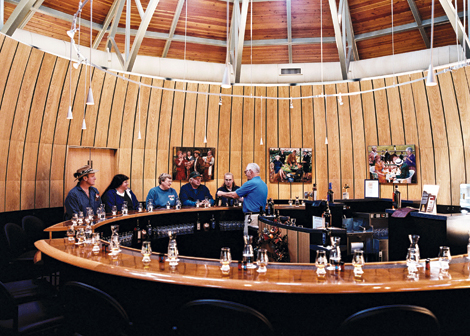
Heading back toward Bardstown, our next stop was Heaven Hill Distilleries, Inc. Rising above a barren, yellowing landscape, ominous metal warehouses spaced great lengths apart—a preventative measure against fire—are coated with torula, a black residue that results from the maturation process. It’s a sight that’s eerie and beautiful.
The tour includes an inspection of one of the 47 warehouses, but not before an introduction to this family-owned distillery. In fact, Heaven Hill is the only distillery on the trail that remains in the hands of its founding family, the Shapiras. The award-winning Bourbon Heritage Center offers insight into the company’s history and liquor-making process. And the expansive gift shop sells everything from bourbon-scented candles to bourbon-flavored sauces. The real treat, though, is the tasting.
Our tour guide, Billy Joe Nalley, ushered us into the “Taste of Heaven” tasting room, which sits inside an enormous barrel. We took seats around a circular bar and watched as Nalley prepared samples of various labels. “To really taste a bourbon, you should evaluate its color, aroma, flavor, and finish,” he began. Much like you’d taste wine, you want to look at the clarity and color before swirling the glass to open up the bouquet. “Now hold the glass to your nose and inhale,” he asked. “What do you smell?” Smoke, wood, caramel, vanilla, and black pepper were all distinct scents. We took a sip, then Nalley instructed us to add an ice cube and splash of water and try again. It tasted different, smoother.
Saying goodbye to the region, I was reluctant to miss seeing the newest member of the Trail, the Tom Moore Distillery. At the time of my visit, it had just opened. However, if you’re only planning to see one distillery, it’s a good place to visit, as it is one of the few that offer a truly behind-the-scenes tour of every aspect of production.
Getting There
Heaven Hill Distilleries, Inc., 1311 Gilkey Run Rd., Bardstown, KY, (502) 337-1000, www.heavenhill.com. Free tours Tuesday-Saturday, 10 a.m.-5 p.m., year-round; Sundays, noon-4 p.m., March-December.
Tom Moore Distillery, 300 Barton Rd., Bardstown, KY, (502) 348-3774, www.1792bourbon.com. Free tours (by appointment only) Monday-Friday, 9:30 a.m. and 1:30 p.m.
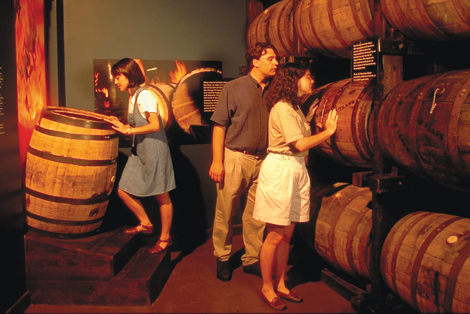
The only distillery on our itinerary that doesn’t offer a guided tour is Jim Beam in Shepherdsville. I guess when you have the best-selling bourbon in the world you don’t need to show people around to sell yourself. However, you can take your own trip through a handful of indoor and outdoor exhibits, including an interesting display inside The American Outpost visitor’s center, which also houses the gift shop full of neon signs, T-shirts, autographed bottles, and other paraphernalia bearing the Jim Beam name.
While you’re there, don’t miss the exhibit hall detailing the Beam family tree, which dates back more than 200 years and seven generations. There have been many names in bourbon’s long heritage—the Browns, Samuels, Wathens, Ripys, Van Winkles—but none can compare to the impact the Beam dynasty has had on the industry. Since its first batch of sour mash in 1795, the family has influenced 60 different bourbon brands in at least three countries. As Hank Williams Jr. affirms, “It’s a family tradition,” one that has brought insurmountable wealth to the state. Bourbon generates more than $3 billion annually for Kentucky, and Jim Beam is responsible for more than one-third of the production.
I gave this some thought while comparing Basil Hayden’s against Booker’s and Baker’s, all part of Jim Beam’s small batch collection and all family names. My favorite? Basil Hayden’s light body and mellow taste with hints of peppermint.
Getting There
Jim Beam, 149 Happy Hollow Rd., Shepherdsville, KY, (502) 543-9877, www.jimbeam.com. Self-guided tours and free tastings, Monday-Saturday, 9 a.m.-4:30 p.m.; Sunday, 1-4 p.m.
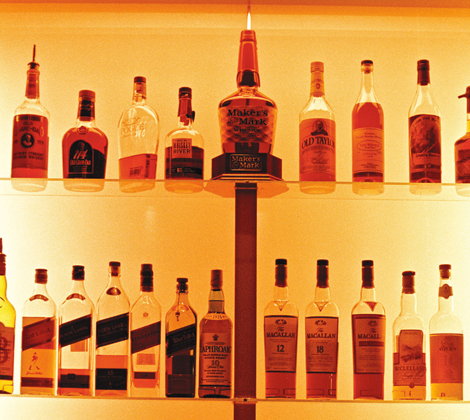
Capping our final day on the trail, we checked into 21c Museum Hotel in Louisville, a contemporary art gallery and hotel, and set out to test our newfound knowledge on the Urban Bourbon Trail, which encompasses seven bourbon bars around town. Since all are within walking distance, we opted for dinner at Bourbons Bistro, where I confidently ordered a flight of bourbon—goodbye one-ounce-per-distillery rule—to accompany my entrée.
To complete our tour, we took in three of the establishments. The lavish lobby of The Brown Hotel seemed the appropriate setting to enjoy an Old Fashioned, while Maker’s Mark was the drink of choice at its Maker’s Mark Bourbon House and Lounge. We finished the night at Proof on Main, the chic restaurant and bar in our hotel that serves an exclusive flight combination: Old Forester, Pappy Van Winkle’s Family Reserve, and Woodford Reserve.
I have to admit, this is the night I may have overindulged. My taste buds were shot after round two, and once the effects of the alcohol set in, it became rather difficult to tell the difference from one bourbon to the next. But one thing I know for sure: Bourbon is now my drink of choice.
Kentucky Bourbon Trail
(502) 875-9351, www.kybourbontrail.com
Urban Bourbon Trail
www.justaddbourbon.com
STAY
• 21c Museum Hotel: 700 W. Main St., Louisville, (877) 217-6400, www.21chotel.com
• Gratz Park Inn: 120 W. 2nd St., Lexington, (800) 752-4166, www.gratzparkinn.com
• Inn at Woodhaven: 401 S. Hubbards Ln., Louisville, (502) 895-1011, www.innatwoodhaven.com
• Jailer’s Inn Bed & Breakfast: 111 W. Stephen Foster Ave., Bardstown, (502) 348-5551, www.jailersinn.com
• Swann’s Nest at Cygnet Farm:3463 Rosalie Ln., Lexington, (859) 226-0095, www.swannsnest.com
EAT & DRINK
• Bourbons Bistro: 2255 Frankfort Ave., Louisville, (502) 894-8838, www.bourbonsbistro.com
• The Brown Hotel: 335 W. Broadway Ave., Louisville, (502) 583-1234, www.brownhotel.com
• Jonathan’s at Gratz Park Inn: 120 W. 2nd St., Lexington, (859) 252-4949, www.jagp.info
• Proof on Main: 702 W. Main St., Louisville, (502) 217-6360, www.proofonmain.com
• Maker’s Mark Bourbon House and Lounge: 446 S. Fourth St., Louisville, (502) 568-9009, www.makerslounge.com
• Xavier’s: 112 Xavier Dr., Bardstown, (502) 349-9464
PLAN AHEAD
September is Kentucky Bourbon Heritage Month, when Bardstown hosts the Kentucky Bourbon Festival. There are nearly 40 events and attractions—bourbon tastings, theme parties, tours, competitions, and an auction of rare bottles. Mostly free; some tickets required.
(800) 638-4877, www.kybourbonfestival.com
Bourbon vs. Whiskey: Whiskey can be a bourbon, but bourbon can never be a whiskey. If it sounds confusing, keep this in mind: A bourbon (often called bourbon whiskey) must consist of at least 51 percent corn, distilled at no more than 160 proof, have been aged in the United States for at least two years in new, charred white oak barrels, and have nothing but water added to enhance the flavor or color. If it doesn’t say “bourbon” on the label, then you know at least one of these four federally-regulated rules has been compromised.
What’s in a Name? Forget what you’ve heard about how Bourbon County, Kentucky, is the only place that can call their product bourbon. It isn’t true, but it is how the spirit got its name. Before 1789, Bourbon County encompassed most of Northern and Central Kentucky. By the 1820s, the area was divided into several counties, but the region was still called “Old Bourbon.” Thus, any whiskey shipped from Limestone, the major port on the Ohio River, was advertised and identified on barrelheads as “Old Bourbon Whiskey,” no matter where it was actually produced. It wasn’t until 1964 that legal regulations for labeling were introduced by Congress under the Federal Standards of Identity for Bourbon. From then on, only liquors made according to bourbon standards could be called “bourbon.”
Who figured it out? During the late 1700s, most farmers in Kentucky were distilling their excess grains (primarily corn) into whiskey. A Baptist minister, Elijah Craig, is often credited as being the father of bourbon. However, no evidence exists that his corn liquor was at all different from anyone else’s, or that he was the first to use corn as his main ingredient. The person credited with inventing the sour mash process and who is also believed to be the first to age whisky in white oak barrels is Dr. James C. Crow, a Kentucky distiller during the early to mid 1800s.
From Bourbon Country to Bourbon Street: New Orleans helped popularize Kentucky’s bourbon. During the late 1700s, Bourbon County’s corn liquor was barreled and shipped down the Ohio and Mississippi Rivers to New Orleans. The shipment took up to six months to arrive; thus aging the liquor in the process. It was smoother and tasted better than other spirits at the time, and soon demand increased for what came to be called bourbon.
1. Angel’s Share: The smell inside a warehouse. It’s the portion of alcohol that’s lost to evaporation during the aging process.
2. Barrel Proof: A label given to bourbon bottled straight from the barrel. No water has been added to lower the proof
3. Bottled-in-Bond: This label signifies an 1897 regulation that was set up to protect the quality of the product (security bondsmen actually guarded federal warehouses that were classified as bottled-in-bond), ensuring to the customer that the whiskeys are 100 proof and at least four years old. Medical whiskey sold during Prohibition was also labeled Bottled-in-Bond.
4. Bourbon (straight): A whiskey made from at least 51 percent corn, distilled at a maximum of 160 proof, aged in the U.S. at no more than 125 proof for a maximum of two years in new, charred, white oak barrels, and water is the only thing that can be added to enhance the color or flavor.
5. Fermentation: The process in which yeast transforms sugar into alcohol and carbon dioxide
6. Mash: The mixture of water and cooked grains (corn, barley, and rye or wheat)
7. Mashbill: The grain recipe
8. Proof: The percentage of alcohol by volume doubled. The term came about during bourbon’s early days when 50 percent alcohol by volume was standard, and therefore referred to as 100 proof.
9. Rackhouse: Commonly called the warehouse, or sometimes rickhouse, for aging bourbon, it’s representative of a style of construction where wooden structures, called ricks, hold the barrels, and freestanding walls and a roof are built around the stacked ricks.
10. Rye Whiskey (straight): Similar standards of bourbon straight, but rather than corn, this mash contains at least 51 percent rye
11. Single Barrel: Bourbon bottled from the contents of just one barrel
12. Small Batch: Bourbon bottled from the contents of multiple barrels, but not exceeding more than 100, which is considered high volume
13. Sour Mash: Leftover mash from the previous distillation is called backset and has a slightly sour taste, hence the term. A small percentage of this sour mash is added to the next distillation to ensure the Ph of the mash will be uniform from batch to batch.
14. Wheated Bourbon: Bourbon made from a mashbill consisting of wheat rather than rye
Blue Grass Cooperage Tour: The making of the American white oak barrel used to age bourbon is an art in and of itself. Each is pain-stakingly crafted with a precise number of staves held in place by iron hoops—no glue or nails. A tour of Blue Grass Cooperage in Louisville, one of only two major manufacturers of bourbon barrels in the U.S., offers the chance to witness the techniques behind the most fundamental component of the aging process. Book through Mint Julep Tours. (866) 986-8779, www.mintjuleptours.com
Lexington Distillery District: Situated on 25 acres of what used to be the tobacco and bourbon corridor in downtown Lexington, the District has plans underway to resurrect two former distillery properties, Old Tarr and James E. Pepper. Additionally, this evolving development will house commercial, residential, and retail space, as well as art studios, a museum, and entertainment venues. The Old Tarr distillery opened in August, revamped as a Buster’s Billiards and Backroom, Lexington’s only mid-size venue for live music. The first phase of the Pepper Distillery is expected to open by the fall of 2010 with an interactive Bourbon Center, contemporary art gallery, and bourbon-themed restaurant on the banks of the Town Branch Creek. Full completion of the district is at least five years away, but in the meantime, it will welcome visitors as the eastern gateway to the Kentucky Bourbon Trail. www.lexingtondistillerydistrict.com
Rebecca Ruth’s Candy Factory Tour: There are many recipes for bourbon balls, liquor-laced creams encased in dark chocolate and capped with a pecan, but none can compare to the original. Founded by Rebecca Gooch and Ruth Hanley Booe in 1919, and now run by third-generation candy maker Charles Booe, Rebecca Ruth’s Candy Factory sells assorted confections, including their signature bourbon-candy creation, and offers tours for $2 that are as much about the history as they are the process. January through March, groups of 10 or more by appointment only; April through November, walk-ins and groups of 10 or more by appointment. 112 E. 2nd St., Frankfort, (800)444-3766, www.rebeccaruth.com
Urban Bourbon Trail: The ultimate pub-crawl, Louisville’s Urban Bourbon Trail is a great place to test your bourbon knowledge and expand your palate. The trail encompasses seven downtown restaurants and bars that serve 50-plus labels of the libation. Each offers a different atmosphere, from the 1920s jazz-club feel of The Old Seelbach Bar to the chic, contemporary Proof On Main. Pick up a passport at any of the participating bars and have it stamped to win a small reward. www.justaddbourbon.com
Kentucky Bourbon Festival: September is National Bourbon Heritage Month, and there’s no better place to get your fill than in Bardstown during the Kentucky Bourbon Festival, September 14-19, 2010. Nearly 40 events and attractions round out the week—from bourbon tastings to theme parties, historical tours and seminars to competitions, cooking classes, and even an auction of rare bottles. Most events are free, but some require reservations and tickets. (800)638-4877, www.kybourbonfestival.com